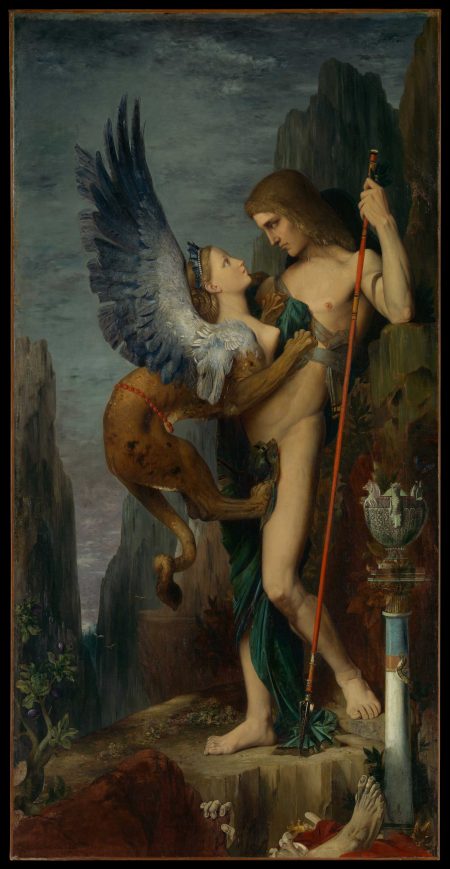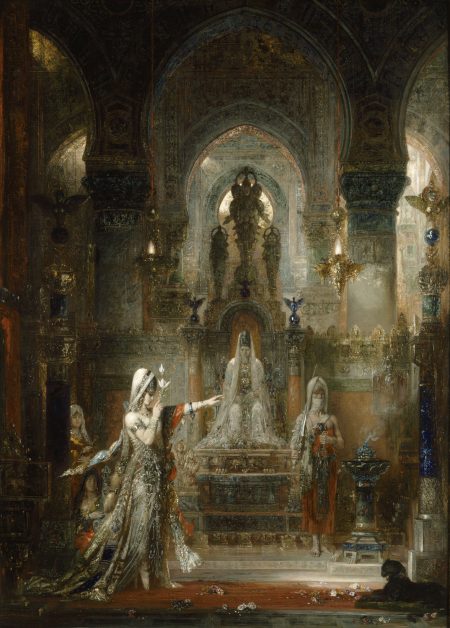
“The Apparition”, Watercolor on Paper, 41 x 28”, 1874-76, Paris, Musee du Louvre. This large watercolor was also presented to the 1876 Salon along with the Salome oil painting.
Damn. I should take drugs when I paint. Look at French painter Gustav Moreau. He must have taken something to make these mind-bending paintings in the 1800’s. I know contemporary painter Peter Doig takes drugs because he admitted so, figures; his paintings are breathtakingly hypnotic, mystical, irrationally emotional and compelling. But Moreau? He’s dead. We can’t ask. We can check sources. I haven’t. Yet. I’m just ruminating because Moreau’s Salome (Salome Dancing Before Herod) is so drug-inducingly-hypnotic, I can barely speak. Or breathe. When I stand before this huge, dark painting, it pulls me into it. Delirious.

“Oedipus and the Sphinx”, 1864 6’9’ X 3’5”1874-76, oil on canvas, New York, Metropolitan Museum of Art.
I begin my ruminations by introducing you to Oedipus and the Sphinx, the painting that you might think of first when you hear the name Gustave Moreau. It is one of his first Symbolist paintings and apparently it took three years to complete and when exhibited at the Salon of 1864 and it made Gustav Moreau famous. The painting depicts Oedipus meeting the Sphinx at the crossroads on his journey, Delphi to Thebes. Oedipus must answer the Sphinx’s riddle to pass and save the besieged Thebans. The riddle was: “What walks on four feet in the morning, two in the afternoon and three at night?” Oedipus answered: “Man: as an infant, he crawls on all fours; as an adult, he walks on two legs and; in old age, he uses a walking stick”. Oedipus was the first to answer the riddle correctly, witness dead body fragments of failed travelers lying below Oedipus at the bottom edge of the painting. Shocked by his correct answer, the Sphinx throws herself into the sea, Oedipus saved the Thebans, and wife Jocasta is later revealed to be his mother.
This painting was the highlight of the 1864 Salon, just as, twelve years later, Moreau’s Salome (Salome Dancing Before Herod) created a sensation when it was exhibited at the Salon of 1876. Over these intervening years, Moreau’s expanding confidence in his vision is evident. His 1864 Oedipus looks distinctly classical; the figures of the Sphinx and Oedipus are smooth as polished marble, exquisite in their smoothly painted perfection, beyond verisimilitude. Moreau has benefitted from looking at fellow Frenchman Ingres, and painted his Oedipus and the Sphinx in the same crisp manner as his predecessor. The light on these mythic figures in balanced so we can view them easily and imagine the myth in our minds. There is great drama here, loaded with Freudian implications played out clearly and unambiguously. But – by the time Salome is painted twelve years later – Moreau had freed himself in numerous ways, becoming more painterly and by expanding his complex historic and cultural referencing, and as a result, Salome is as haunting and ambiguous as a dream.

“Salome (Salome Dancing Before Herod)”, 1874-76, oil on canvas, Los Angeles, Armand hammer Museum of Art
And that is exactly what we have here in Salome. An erotic, mythic-historic dream. What are we looking at? Where are we in this 56.5 by 41.1 inch painting? Are we peering into a dimly lit temple instead of the banquet hall usually the setting of Salome’s fabled dance before Herod (to ask for the head of John the Baptist.)? It is a temple or Orientalized palace with the king in the lower center of the painting seated on his throne. He is more vision than reality, faded, painted in gauzy grey-beiges. Look at his face, haunting in its indistinctness, impotent in the presence of his stepdaughter. Moreau, in all his work, carefully selects the most complex human dramas, the things of myths, Biblical narratives and still alive in our collective consciousness in contemporary fiction and dramas. King Herod wears a tall Persian-like headdress. Why is this temple-setting Orientalized? Moreau owned The Grammar of Ornament by Owen Jones and Moreau used tracings of ornamentation based on Jones’ exhaustive research in numerous oil paintings and watercolors. Moreau no longer cares to situate this terrible story in Judea, southwest of Jerusalem. Moreau’s world here is hybrid, his vision knows no geographic or cultural boundaries.
Salome is herself a Judean princess. Here, she is on pointe, not barefoot dancing the way Cecile B. De mille would have directed his more earthy Salome. Moreau’s Salome is highly staged in near-profile holding a white lotus blossom before her. Might the white lotus reference John the Baptist, his purity and the renewal of his faith as the lotus faithfully opens every morning? No accounts from her time nor since have absolved Salome of her murderous request. The lotus alone is a rich symbol in Egypt and the Orient and is depicted frequently in Egyptian wall carvings grasped in the hand of royalty. Salome appears to be in a trance, there is no suppleness or implied movement. Salome’s left arm is thrust forward as if she is being led, her left hand is outstretched and on her left arm is a bracelet with a fantastically large udjat eye dangling from it. The unblinking eye is unnerving, riveting. No wonder the Surrealists loved Moreau.
You might say this complex painting – comprising multiple arches, pillars, statues, ornate hanging lamps, the five figures of Salome, Salome’s mother Herodias and a maid, Herod and the executioner, also a panther, a floor strewn with roses and a lush array of grillwork, architectural carvings, tile designs, bejeweled and embroidered garments – has really only three colors. They are a lush carmine red suggesting lust, sexuality and blood, a graying green, suggesting decay especially in Herod’s agedness, and shots of pearly white punctuating the dark scene. Even Salome’s skin is nearly alabaster in hue. There are other colors of course to create the alluring scene; glints of gold, especially in the elaborate hanging lamps, deep blues, probably indigo to create the depths of the darkness, small areas of fleshy pink. But overall, this overly-image-packed painting has a very restrained palette. That is why it is more a dream than real, as if upon waking, we dimly remember and re-envision the scene that was played out during the night.
When I was in Paris years ago I made a point of visiting Paris’ Musée National Gustave Moreau. The museum is his former residence and workshop, though of course most of his acclaimed paintings are in museums such as Oedipus and the Sphinx in the Metropolitan in New York. Yet the museum is a rich treasure; there are paintings, countless small studies, watercolors, books, sketchbooks and wax figures he created for study. André Breton famously used to “haunt” the museum and regarded Moreau as a precursor of Surrealism. I believe it is not widely known to the public how many watercolors Moreau painted – thousands – and in later years his watercolors, like Turner’s later watercolors, became more abstract and free. Moreau became a professor at Paris’ École des Beaux-Arts in October 1891. His students included Henri Matisse and Georges Roualt.
Important exhibitions of the work of Gustave Moreau include “Between Epic and Dream: Gustav Moreau” which opened at the Galeries Nationales du Grand Pala is, Paris in 1998, traveled to the Art Institute of Chicago in 1999, where I saw Salome in person as well as numerous other paintings, watercolors and wax figures Moreau fashioned for study. The exhibition concluded in New York at the Metropolitan Museum of Art in 1999.
In 2012, the Hammer Museum in Los Angeles presented an exhibition devoted to its own Salome Dancing before Herod, which the museum stated is “one of the most remarkable and best-known paintings in the museum’s collection.” The exhibition comprised of approximately 50 works—including related paintings, drawings, and preparatory studies—drawn entirely from the collection of the Gustave Moreau Museum in Paris. Many of the works had never before been seen in the United States, and the Hammer was the sole American venue. During his lifetime, Moreau produced more than 8,000 paintings, watercolors and drawings. While only a few treasured paintings are in American collections, we have two of his finest.
–Cynthia Kukla





April 30th, 2020at 4:19 pm(#)
Wow! so many considerations, details, background! Author’s erudition is so very evident.